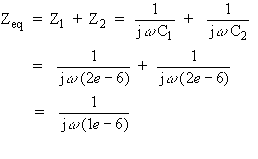Serial and Parallel Combinations of Circuit Elements
Very few electrochemical cells can be modeled using a single equivalent-circuit element. Instead, EIS models usually consist of a number of elements in a network. Both serial and parallel combinations of elements occur.
Fortunately, there are simple formulas that describe the impedance of circuit elements in both parallel and series combinations.
Impedance of parallel components Impedance of series components 

For linear impedance elements in series, calculate the equivalent impedance from:

For linear impedance elements in parallel, calculate the equivalent impedance from:

Here we calculate two examples to illustrate a point about combining circuit elements. Suppose we have a 1 W and a 4 W resistor in series. The impedance of a resistor is the same as its resistance. We thus calculate the total impedance as:

Resistance and impedance both go up when resistors are combined in series.
Now suppose that we connect two 2 mF capacitors in series. The total capacitance of the combined capacitors is 1 mF.

Impedance goes up, but capacitance goes down when capacitors are connected in series. This is a consequence of the inverse relationship between capacitance and impedance.

Comments are closed.